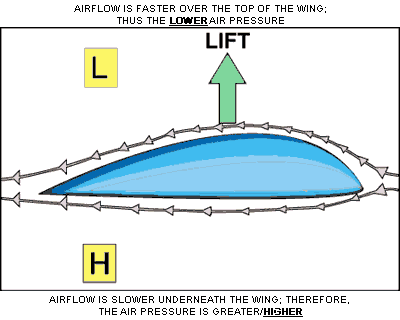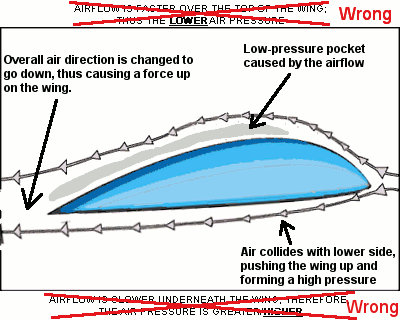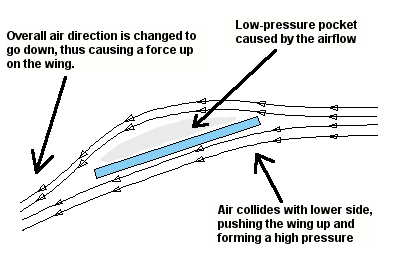
This is one of the most persistent and widespread aerodynamic physics myths in modern history. Not only do they teach this wrongly in schools around the world (all the way from grade schools to even some universities), but it's a myth strongly believed even by professional engineers dealing with the subject (for example, it's a rather common myth among Formula 1 car design engineers). This myth is even more persistent and widespread than the solar windmill myth and the weight-of-air-proven-with-balloon myth.
I once saw a Formula 1 engineer recite this myth on a F1 broadcast. Recently this myth was indirectly repeated in the show Mythbusters (episode 100). Curiously they were not testing this myth, they simply mentioned, and I quote (emphasis mine): "Kari is concerned that MacGyver's wings look too flat, not the classic airfoil shape that makes powered flight possible." It's clearly implied that flight is impossible with flat wings which do not have the airfoil shape.
This myth is so prevalent and persistent that even Albert Einstein, one of the most brilliant physicists of all time, believed it and got it all wrong.
The so-called "airfoil shape" is this (with the classical but wrong explanation):

The myth is: The lift is produced solely because the air travels a longer path on the upper side of the wing than the lower side. Allegedly the Bernoulli effect this causes is strong enough to lift the airplane. Usually this is the only explanation given for the lifting force.
Moreover, some people (like in the Mythbusters episode) go further ahead and claim that flight is not possible without wings with the airfoil shape.
Of course both claims are laughably easy to disprove: If this was so, then it would be impossible to fly a plane upside-down. Flying a plane upside-down would mean that the lift is reversed and would then point towards the ground, which would make the plane fall like a rock.
Naturally anyone who has seen an airshow knows that airplanes can indeed fly upside-down.
Also, most scale model airplane aficionados know from experience that a plane with flat wings can indeed fly. The cross-shape of the wing is not really all that critical for flight to be possible (either normally or upside-down).
Also, the Bernoulli effect requires the air to move at different speeds, not different distances. The air going over the wing does not move significantly faster than the air going under the wing (which means that the air going over the wing lags behind a bit). Thus there's no significant Bernoulli effect caused by this.
So what is it that causes the lift if not the shape?
The classic airfoil shape actually does affect the lifting force, but it doesn't do so in the way as erroneously described, nor is it all that critical for flight to be possible. Also, the Bernoulli effect is part of the physics involved, but again not in the way as erroneously described, nor does it require the airfoil shape.
There are two main phenomena which in conjunction cause the lift:
In other words, air arrives at the front edge of the wing horizontally, and leaves the back edge of the wing slightly deviated downwards. By Newton's law, since there was a force which caused the air to be deflected downwards, an equivalent force in the opposite direction causes the wing to go upwards. The so-called angle of attack affects greatly how much this force comes into play.
Here's where Bernoulli steps in: The air which is closer to the wing's upper surface is travelling slower than the stream of air making the arc over the wing. Because of the Bernoulli effect this causes a low-pressure pocket on the upper surface of the wing.
At the same time the pressure of air on the lower side of the wing is much higher (because the air is more compressed, more "packed" there because it's colliding with the wing's lower surface). The low-pressure pocket on the upper side of the wing causes a significant lift.
As said, the low-pressure pocket forms because of the Bernoulli effect, which is why Bernoulli plays a role in wing lift, but not in the way it's classically explained.
Possible differences in airflow speed between the upper and lower streams might play a very minor role, but it's probably insignificant (and could not possibly all by itself lift the plane).
Fixing the previous image, this would be more correct:

A flat wing works too, but needs a steeper angle of attack for the low-pressure pocket to form on the upper side of the wing (and to cause a stronger deviation of the air downwards to compensate for the weaker lifting force caused by the weaker low-pressure pocket). The disadvantage of this is that a steeper angle of attack causes more drag. The airfoil-shaped wing is more economical because it causes the low-pressure pocket without the need for a steep angle of attack, thus reducing drag.
This is what happens with a flat wing:

A flat wing requires a steeper angle of attack to achieve the same amount of lift, and the consequence of this is increased drag.
That is the reason why the airfoil shape is optimal for flight, not because it would be mandatory for flight to happen.
In practice planes tend to have more a tear-shaped cross-section in their wings, making it almost symmetrical. The tear-shape becomes close to the airfoil shape when positioned appropriately. This is the reason why planes can fly upside-down: Both lifting phenomena still work.
Obviously a plane with flat wings can fly equally well normal-side-up and upside-down. A tear-shaped wing makes it more economical, though.
Note that helicopter rotor blades are basically flat wings in a steep angle. The mechanism by which they form lift is exactly the same. Rotor blades are usually not airfoil-shaped or tear-shaped because drag is less of a concern. On the other hand, the angle of attack of the blade is very critical because the vertical lift of the helicopter is controlled by changing the angle of the blades. In this case flat blades might even work better for this purpose than airfoil-shaped ones would.
If the myth was correct, however, then flat rotor blades would not produce the lift necessary for helicopters to fly.